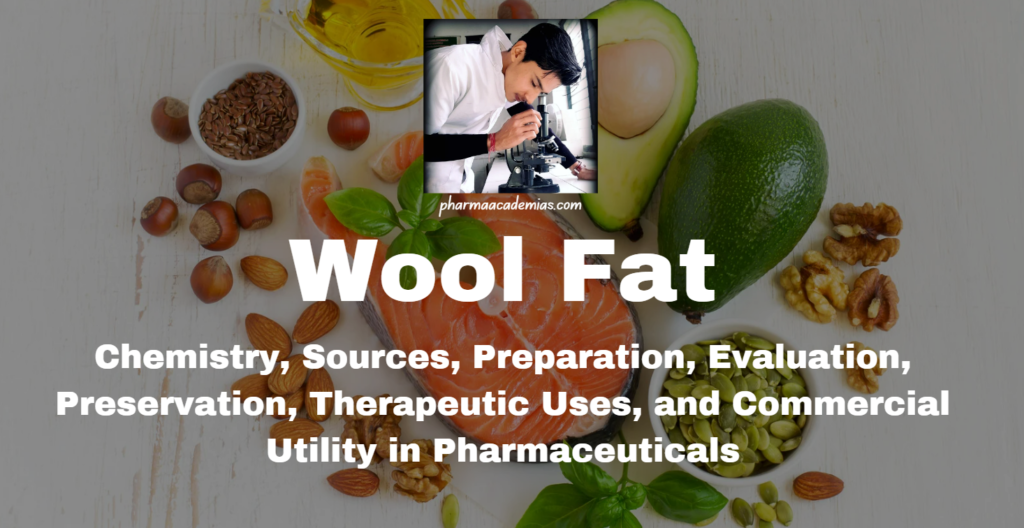General Introduction:
Wool fat, commonly known as lanolin, is a natural wax secreted by the sebaceous glands of wool-bearing animals, primarily sheep. It is a byproduct of wool processing and has been used for centuries for its emollient and protective properties. Lanolin is widely utilized in pharmaceutical and cosmetic applications due to its ability to mimic human skin lipids and its excellent moisturizing properties.
Chemistry of Wool Fat
Chemical Composition: Wool fat is a complex mixture of esters, fatty acids, and alcohols. Key components include cholesterol, lanosterol, and various long-chain fatty acids and alcohols.
Physical Properties: It is a yellow, waxy substance with a slight odor. It is insoluble in water but can form stable water-in-oil emulsions.
Chemical Properties: Wool fat is chemically similar to the lipids found in human skin, which contributes to its high compatibility and effectiveness as a moisturizer and protective agent.
Sources of Wool Fat
Natural Source: Wool fat is obtained from the wool of sheep. It is secreted by the sebaceous glands to protect the wool and skin of the animal.
Geographical Distribution: Major producers include countries with large sheep populations, such as Australia, New Zealand, the United Kingdom, and China.
Preparation:
Extraction Methods of Wool Fat
Scouring: Wool is washed in hot water and detergent to remove wool fat, dirt, and other impurities.
Centrifugation: The mixture is then centrifuged to separate the wool fat from the water and detergent.
Refining: The crude wool fat undergoes refining processes, including deodorization and bleaching, to produce pharmaceutical-grade lanolin.
Evaluation of Wool Fat
Quality Control: Wool fat is evaluated for its purity, melting point, acid value, and water content.
Standards: It must meet standards set by pharmacopeias such as the USP (United States Pharmacopeia) and BP (British Pharmacopoeia).
Preservation and Storage of Wool Fat
Storage Conditions: Wool fat should be stored in a cool, dry place in tightly sealed containers to prevent oxidation and contamination.
Preservation Methods: Antioxidants may be added to enhance shelf life and prevent rancidity.
Therapeutic Uses of Wool Fat
Skin Moisturizer: Lanolin is widely used as an emollient in creams and lotions to treat dry, rough, and scaly skin conditions.
Wound Healing: It promotes the healing of minor cuts, burns, and abrasions by creating a protective barrier and maintaining moisture.
Nipple Creams: Lanolin is used in nipple creams for breastfeeding mothers to soothe and protect sore and cracked nipples.
Lip Balms: Its moisturizing properties make it a key ingredient in lip balms and treatments for chapped lips.
Dermatitis and Eczema: Lanolin is used in treatments for dermatitis and eczema due to its ability to soothe and hydrate irritated skin.
Commercial Utility as Pharmaceutical Aids and/or Medicines
Pharmaceutical Formulations: Wool fat is used as an excipient in ointments, creams, and lotions to improve texture and moisture retention.
Emulsifying Agent: It acts as an emulsifying agent in the formulation of water-in-oil emulsions.
Base for Topical Applications: Lanolin is used as a base for topical medications, enhancing their absorption and efficacy.
Protective Barrier: It is utilized in barrier creams to protect the skin from irritants and excessive moisture loss.
Conclusion:
Wool fat, or lanolin, is a versatile and valuable natural product with extensive applications in pharmaceuticals and cosmetics. Its unique chemical composition and excellent moisturizing properties make it an essential ingredient in various formulations for skin care and protection. Proper evaluation, preservation, and storage are crucial to maintaining its quality and effectiveness, ensuring its continued utility as a pharmaceutical aid and medicine.



